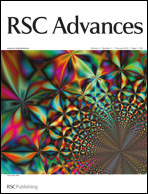The curing and thermal transition behavior of epoxy resin: a molecular simulation and experimental study
Abstract
Curing and thermal transition behavior of two epoxy resins i.e. 2,2′-dimethyl-4,4′-diaminobiphenyl (MTB)–4,5-epoxycyclohexyl-1,2-diglycidyl diformate (TDE85) and 2,2′-bis(trifluoromethyl)-4,4′-diamino biphenyl (TFMB)–4,5-epoxycyclohexyl-1,2-diglycidyl diformate (TDE85) with different chemical structures were experimentally and theoretically investigated via molecular simulations to establish the structure–property relationships. The slight modification in the diamine structure resulted in significant changes in the curing and glass transition behavior of epoxy resin. As the side group of the


 Please wait while we load your content...
Please wait while we load your content...